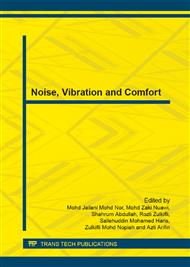p.25
p.30
p.35
p.40
p.45
p.52
p.59
p.64
p.69
Preprocessing and Solving Finite Element Analysis for NVH Prediction
Abstract:
Current vehicle development period has become shorter; therefore, virtual testing has been considered as vital to assist design decision at the early stage of the development. Over the last three decades, Finite Element Method (FEM) is widely used to predict the Noise and Vibration level of a vehicle. With the latest technology of Computer Aided Engineering (CAE) simulation, the calculation time taken for NVH analysis can be reduced from few days to only few hours. This paper presents current simulation technique for automotive development using Altair Hyperworks as preprocessing tool for vehicle modeling as well as application of NASTRAN as calculation solver. Normal Mode analysis is conducted on the Trimmed Body to investigate the natural frequency of the steering and the vehicle resonance. The result obtained is comparable with the actual prototype testing result to present the level of correlation. Coupling structural-acoustic analysis also conducted to predict the Noise Transfer Function (NTF) at the driver's ear.
Info:
Periodical:
Pages:
45-51
Citation:
Online since:
December 2013
Keywords:
Price:
Сopyright:
© 2014 Trans Tech Publications Ltd. All Rights Reserved
Share:
Citation:


